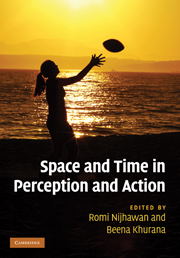Book contents
- Frontmatter
- Contents
- List of contributors
- Acknowledgments
- 1 Space and time: the fabric of thought and reality
- Part I Time–space during action: perisaccadic mislocalization and reaching
- Part II Temporal phenomena: perception
- Part III Temporal phenomena: binding and asynchrony
- Part IV Spatial phenomena: forward shift effects
- 19 The Fröhlich effect: past and present
- 20 Approaches to representational momentum: theories and models
- 21 Conceptual influence on the flash-lag effect and representational momentum
- 22 Perceptual asynchronies and the dual-channel differential latency hypothesis
- 23 Paying attention to the flash-lag effect
- 24 Illusions of time, space, and motion: flash-lag meets chopsticks and reversed phi
- 25 Bridging the gap: a model of common neural mechanisms underlying the Fröhlich effect, the flash-lag effect, and the representational momentum effect
- 26 Perceiving-the-present and a unifying theory of illusions
- 27 History and theory of flash-lag: past, present, and future
- Part V Space–time and awareness
- Index
- References
22 - Perceptual asynchronies and the dual-channel differential latency hypothesis
from Part IV - Spatial phenomena: forward shift effects
Published online by Cambridge University Press: 05 October 2010
- Frontmatter
- Contents
- List of contributors
- Acknowledgments
- 1 Space and time: the fabric of thought and reality
- Part I Time–space during action: perisaccadic mislocalization and reaching
- Part II Temporal phenomena: perception
- Part III Temporal phenomena: binding and asynchrony
- Part IV Spatial phenomena: forward shift effects
- 19 The Fröhlich effect: past and present
- 20 Approaches to representational momentum: theories and models
- 21 Conceptual influence on the flash-lag effect and representational momentum
- 22 Perceptual asynchronies and the dual-channel differential latency hypothesis
- 23 Paying attention to the flash-lag effect
- 24 Illusions of time, space, and motion: flash-lag meets chopsticks and reversed phi
- 25 Bridging the gap: a model of common neural mechanisms underlying the Fröhlich effect, the flash-lag effect, and the representational momentum effect
- 26 Perceiving-the-present and a unifying theory of illusions
- 27 History and theory of flash-lag: past, present, and future
- Part V Space–time and awareness
- Index
- References
Summary
Summary
The dual-channel differential latency hypothesis (Öğmen et al. 2004) successfully accounts for many aspects of the flash-lag effect (FLE). Here we use the dual-channel differential latency hypothesis to explain an illusion of perceived line length that can be viewed as one component of an illusion reported by Cai and Schlag (2001a). In the phenomenon studied here, a flash is presented collinear with a moving line that is simultaneously changing in length. The moving line is perceived to be misaligned with the flash (the FLE) and the length of the moving line is perceived to differ from its physical length at the instant of the flash. We designate this phenomenon the Cai line-Length Effect (CLE). Our analysis treats a horizontally moving line that also changes its vertical length as composed of two simultaneous motion components: (1) horizontal motion, and (2) vertical expansion or contraction. We measured perceived position misalignment and length misperception in the CLE paradigm, as well as separately for stimuli with the individual motion components of the CLE, as a function of target luminance. Perceived position misalignment and length misperception varied similarly with target luminance, both in the CLE paradigm and when the individual motion components were tested separately. The misperception of stimulus position and length in the CLE reflects an additional processing delay that may be caused by an interaction between the motion components in two directions. […]
Information
- Type
- Chapter
- Information
- Space and Time in Perception and Action , pp. 379 - 395Publisher: Cambridge University PressPrint publication year: 2010
